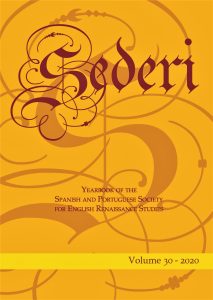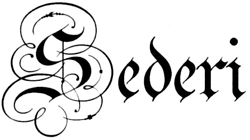
Sederi 30
Sederi 30 — 2020
EDITOR
Ana Sáez-Hidalgo
REVIEW EDITOR
María José Mora
ISSN 1135-7789
Katherine Romack, “The Romance of Nahum Tate’s King Lear.” SEDERI 30 (2020): 91–115.
DOI: https://doi.org/10.34136/sederi.2020.5 Download PDF
Abstract
Nahum Tate’s History of King Lear (1681) refigures Shakespeare’s natural man on a Hobbesian model in order to make the play legible to Restoration audiences. As a way to mitigate Hobbes’s ethically hollow conception of human nature as acquisitive and self-interested, Tate provides his viewers with a compensatory romance. Tate’s “unaccommodated Man” is governed by self-interest yet capable of transcendent love (3.3.81). The liberties Tate took with Shakespeare catered to his audience’s uneasy assimilation of secular and empirical ideas about what it meant to be human that made Shakespeare’s original feel both alien and disturbing. The romanticized human nature offered up in Tate’s Lear accounts for the success the play enjoyed well into the nineteenth century. As much as we might give the adaptation the side-eye, we are, in fact, affectively and ethically closer to Tate than we are to Shakespeare.
Keywords: King Lear; Nahum Tate; Shakespeare; ethics; Christianity; romance
References
Abrams, Richard. 1985. “The Double Casting of Cordelia and the King’s Fool: A Theatrical View.” Texas Studies in Literature and Language 27 (4): 354–68.
Addison, Joseph, and Richard Steele. 1739. The Spectator. 12th ed. London: Printed for J. and R. Tonson and S. Draper.
Adler, Doris. 1985. “The Half-Life of Tate in King Lear.” The Kenyon Review 7 (3): 52–56.
Agacinski, Sylviane. 2004. “The Question of the Other (Critique of Egocentrism).” In French Women Philosophers, A Contemporary Reader, edited by Christina Howells, 39–55. London: Routledge.
Álvarez-Recio, Leticia. 2009. “Nahum Tate’s The History of King Richard the Second (1681): Politics and Censorship during the Exclusion Crisis.” Restoration and Eighteenth-Century Theatre Research 24 (1): 17–30.
Álvarez-Recio, Leticia. 2012. “Romance, Politics and Money: The French Cause in The True Chronicle History of King Leir.” English Studies 93 (6): 652–67.
Aristotle. 1932. Aristotle: The Poetics. Longinus: On the Sublime. Demetrius: On Style. Edited by W. Hamilton Fyfe. London: W. Heinemann.
Belsey, Catherine. 1985. The Subject of Tragedy: Identity and Difference in Renaissance Drama. London: Methuen.
Bender, Ashley. 2016. “Rhetorical Bodies in Nahum Tate’s King Lear and Ingratitude of a Commonwealth.” Papers on Language and Literature 52 (1): 63–90.
Black, James. 1967a. “An Augustan Stage History: Nahum Tate’s King Lear.” Restoration and 18th Century Theatre Research 6 (1): 36–54.
Black, James. 1967b. “The Influence of Hobbes on Nahum Tate’s King Lear.” Studies in English Literature 7 (3): 377–85.
Blount, Charles. 1679. Anima mundi, or, An historical narration of the opinions of the ancients concerning man’s soul after this life according to unenlight[e]ned nature. London: Printed by Will. Cademan.
Blount, Charles. 1680a. Great is Diana of the Ephesians, or, The original of idolatry together with the politick institution of the gentiles sacrifices. London.
Blount, Charles. 1680b. The Two First Books of Philostratus concerning the Life of Apollonius Tyaneus written originally in Greek, and now published in English: together with philological notes upon each chapter. London: Printed for Nathaniel Thompson.
Brownlee, Marina Scordilis. 1983. “Writing and Scripture in the Libro De Apolonio: The Conflation of Hagiography and Romance.” Hispanic Review 51 (2): 159–74.
Coleridge, Samuel Taylor. 1874. Shakespeare, Ben Jonson, Beaumont and Fletcher: Notes and Lectures. Edited by Edward Howell. Liverpool: Edward Howell.
Coli, Daniela. 2006. “Hobbes’s Revolution.” In Politics and the Passions, 1500–1850, edited by Victoria Kahn, Neil Saccamano, and Daniela Coli, 75–92. Princeton: Princeton University Press.
Daston, Lorraine. 1998. Classical Probability in the Enlightenment. Princeton: Princeton University Press.
Depledge, Emma. 2014. “The Politics of Rape in Nahum Tate’s The History of King Lear, 1681.” In Renaissance Shakespeare: Shakespeare Renaissances, edited by Martin Procházka, Michael Dobson, Andreas Höfele, and Hanna Scolnicov, 317–24. Newark: University of Delaware Press.
Deyermond, Alan D. 1975. “The Lost Genre of Medieval Spanish Literature.” Hispanic Review 43: 231–59.
Dodd, William. 1999. “Impossible Worlds: What Happens in King Lear, Act 1, Scene 1.” Shakespeare Quarterly 50 (4): 477–507.
Eagleton, Terry. 1990. The Ideology of the Aesthetic. Oxford: Basil Blackwell.
Elias, Norbert. 1978. The Civilizing Process. Vol. 1: The History of Manners. Translated by Edmund Jephcott. New York: Urizen Books.
Elton, William R. 1988. King Lear and the Gods. Lexington: University of Kentucky Press.
Empson, William. 1949. “Fool in Lear.” The Sewanee Review 57 (2): 177–214.
Felperin, Howard. 2000. “‘This great miracle’: Pericles.” In Pericles: Critical Essays, edited by David Skeele, 114–32. New York: Garland.
Fuchs, Barbara. 2004. Romance: A Critical Idiom. New York: Routledge.
Gildon, Charles. 1710. “Remarks on the Plays of Shakespeare.” In The Works of Mr. William Shakespear. Volume the Seventh, edited by Nicholas Rowe, 257–444. London; Printed for E. Curll and E. Sanger.
Goldsmith, Oscar James. 1955. Wise Fools in Shakespeare. East Lansing: Michigan State University Press.
Gorer, Geoffrey. 1989. “On Falling in Love.” In Eros, Agape and Philia: Readings in the Philosophy of Love, edited by Alan Sobel, 6–11. New York: Paragon House.
Green, Lawrence D. 1972. “‘Where’s my fool?’—Some Consequences of the Omission of the Fool in Tate’s Lear.” Studies in English Literature 12 (2): 259–74.
Greenblatt, Stephen. 1980. Renaissance Self-Fashioning: From More to Shakespeare. Chicago: University of Chicago Press.
Halpern, Richard. 1991. The Poetics of Primitive Accumulation: English Renaissance Culture and the Genealogy of Capital. Ithaca: Cornell University Press.
Hardman, C. B. 2000. “‘Our Drooping Country Now Erects Her Head’: Nahum Tate’s History of King Lear.” The Modern Language Review 95 (4): 913–23.
Hawkes, Terence. 1959. “‘Love’ in King Lear.” The Review of English Studies 10 (38): 178–81.
Hawkes, Terence, ed. 1995. William Shakespeare, King Lear. Plymouth, U.K.: Northcote House.
Hendricks, Shellee. 1999. “The Curiosity of Nations”: King Lear and the Incest Prohibition. PhD diss. McGill University.
Herbert of Cherbury, Edward. 1633. De veritate, prout distinguitur a revelatione, a verisimili, a possibili, et a falso. London.
Herbert of Cherbury, Edward. 1645. De causis errorum una cum tractatu de religione laici, et appendice ad sacerdotes. London.
Johnson, Odai. 1995. “Empty Houses: The Suppression of Tate’s Richard II.” Theatre Journal 47 (4): 503–16.
Johnson, Samuel. 1765. The Works of William Shakespeare. Vol. 6. London: J. and R. Tonson et al.
Kahn, Victoria. 2002. “Reinventing Romance, or the Surprising Effects of Sympathy.” Renaissance Quarterly 55 (2): 625–61.
Kermode, Frank. 2005. Shakespeare, Spenser, Donne. London: Routledge.
Lee, Christine S. 2014. “The Meanings of Romance: Rethinking Early Modern Fiction.” Modern Philology 112 (2): 287–311.
Lloyd, William Watkiss. 1889. Critical Essays on the Plays of Shakespeare. London: George Bell and Sons.
Massai, Sonia. 2000. “Nahum Tate’s Revision of Shakespeare’s King Lears.” Studies in English Literature 40 (3): 435–50.
May, Simon. 2011. Love: A History. New Haven: Yale University Press.
Muldrew, Craig. 1993. “Interpreting the Market: The Ethics of Credit and Community Relations in Early Modern England.” Social History 18 (2): 163–83.
Muldrew, Craig. 2001. “‘Hard food for Midas’: Cash and its Social Value in Early Modern England.” Past & Present 170: 78–120.
Nunn, Trevor. 2016. “Theatre for a New Audience’s PERICLES, directed by Trevor Nunn.” https://www.youtube.com/watch?v=r7N6RvGMbRQ
Odell, George C. D. (1920) 1966. Shakespeare From Betterton to Irving. Vol. 1. New York: Dover.
Parr, Johnstone. 1946. “Edmund’s Nativity in King Lear.” The Shakespeare Association Bulletin 21 (4): 181–85.
Pascal, Blaise. 1958. Pascal’s Pensées with an Introduction by T. S. Eliot. Translated by W. F. Trotter. New York: E.P. Dutton.
Parker, Patricia A. 1979. Inescapable Romance: Studies in the Poetics of a Mode. Princeton: Princeton University Press.
Patay, Douglas Lane. 1984. Probability and Literary Form: Philosophic Theory and Literary Practice in the Augustan Age. Cambridge: Cambridge University Press.
Rust, Jennifer. 2006. “‘Image of Idolatryes’: Iconotropy and the Theo-Political Body in The Faerie Queene.” Religion & Literature 38 (3): 137–55.
Seiden, Melvin. 1979. “The Fool and Edmund: Kin and Kind.” Studies in English Literature 19 (2): 197–214.
Shakespeare, William. (1608, 1623) 2008. King Lear. In The Norton Anthology of Shakespeare, 9th edition, edited by Stephen Greenblatt et al., 2336–67. New York: W.W. Norton.
Sisson, Charles J. 1942. “Shakespeare’s Quartos as Prompt Copies. With some Account of Chomley’s Players and a New Shakespeare Allusion.” Review of English Studies 18 (70): 129–43.
Spencer, Christopher. 1963. “A Word for Tate’s King Lear.” Studies in English Literature 3 (2): 241–51.
Spinoza, Baruch. 1670. Tractatus theologico-politicus. Hamburg: Henricus Künraht.
Steiner, George. 1968. The Death of Tragedy. New York: Alfred A. Knopf.
Tate, Nahum. (1681) 1997. The History of King Lear. In Shakespeare Made Fit: Restoration Adaptations of Shakespeare, edited by Sandra Clark, 291–373. London: J. M. Dent.
Tierney-Hynes, Rebecca. 2012. Novel Minds: Philosophy and Romance Readers, 1680–1740. New York: Palgrave Macmillan.
Turner, James Grantham. 2012. “‘Romance’ and the Novel in Restoration England.” The Review of English Studies 63 (258): 58–85.
Viator, Timothy J. 1988. “Nahum Tate’s Richard II.” Theatre Notebook 42 (3): 109–17.
Walsh, John K. 1977. “The Chivalric Dragon: Hagiographic Parallels in Early Spanish Romances.” Bulletin of Hispanic Studies (54): 189–98.
Wikander, Matthew H. 1986. “The Spitted Infant: Scenic Emblem and Exclusionist Politics in Restoration Adaptations of Shakespeare.” Shakespeare Quarterly 37 (3): 340–58.
Womack, Peter. 1999. “Shakespeare and the Sea of Stories.” The Journal of Medieval and Early Modern Studies 29 (1): 169–87.
Womack, Peter. 2002. “Secularizing King Lear: Shakespeare, Tate, and the Sacred.” Shakespeare Survey 55: 96–105.
Wood, Ian. 2006. “Pericles and the Simpsons.” Leeds Studies in English 37: 441-50.
